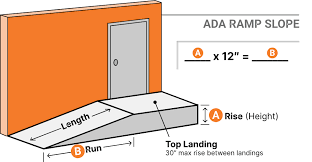Creating accessible environments for individuals with mobility challenges is not just a legal requirement but also a moral imperative. One of the most critical aspects of this accessibility is the design and installation of wheelchair ramps. The slope of a ramp plays a crucial role in ensuring that it is safe and usable for all individuals. This blog post will serve as a beginner’s guide to understanding wheelchair ramp slope calculations, the importance of the right angle, and how to use a wheelchair ramp slope calculator effectively.
Understanding the Importance of Ramp Slope
What is Ramp Slope?
Ramp slope refers to the angle or steepness of the ramp. It is determined by the ratio of the vertical rise to the horizontal run. The slope is vital because it affects the safety and usability of the ramp. A ramp that is too steep can pose risks for users, making it difficult for individuals in wheelchairs to ascend or descend safely. Conversely, a ramp that is too shallow may require excessive space and could be impractical for certain environments.
Why is the Right Ramp Slope Essential?
Having the correct ramp slope is crucial for several reasons:
- Safety: A gentle slope reduces the risk of slipping or losing control while using the ramp. Safety should always be the top priority when constructing ramps.
- Accessibility: An appropriate slope ensures that all individuals, regardless of their physical ability, can use the ramp comfortably and efficiently.
- Compliance: Local building codes and regulations often specify maximum slope ratios. Ensuring compliance helps avoid legal issues and promotes inclusivity.
Understanding the importance of ramp slope sets the foundation for effectively using a wheelchair ramp slope calculator.
Key Guidelines for Ramp Slope
To achieve a safe and effective wheelchair ramp, it is essential to follow some standard guidelines regarding slope ratios. The Americans with Disabilities Act (ADA) provides the following recommendations for wheelchair ramp slopes:
- For Manual Wheelchairs: The recommended slope is 1:12. This means that for every inch of vertical rise, there should be at least 12 inches (1 foot) of ramp run. For example, a 1-foot rise would require a 12-foot ramp.
- For Power Wheelchairs: A slightly steeper slope of 1:10 may be acceptable, but it is always advisable to consult local guidelines or a professional to determine the best slope for specific needs.
- Maximum Rise: The ADA also suggests that ramps should not have a vertical rise greater than 30 inches without landing areas for rest.
These guidelines are essential for ensuring that wheelchair ramps are safe and usable. Now, let’s explore how to use a wheelchair ramp slope calculator to determine the right slope for your specific requirements.
How to Use a Wheelchair Ramp Slope Calculator
Using a wheelchair ramp slope calculator is a straightforward process. Here are the steps to follow:
Step 1: Gather Your Measurements
Before using the calculator, gather the necessary measurements:
- Vertical Rise: Measure the height of the vertical distance that the ramp will cover. This is usually the height from the ground to the entry point, such as a door or platform.
- Desired Slope Ratio: Decide on the appropriate slope ratio based on the type of wheelchair (manual or power) and follow the guidelines mentioned earlier.
Step 2: Input the Measurements
Most wheelchair ramp slope calculators will have input fields where you can enter the vertical rise and the desired slope ratio. For instance, if you measure a vertical rise of 24 inches and want a 1:12 slope, you will enter these values into the calculator.
Step 3: Calculate the Ramp Length
Once you input the necessary values, click the calculate button. The calculator will provide you with the required ramp length based on the vertical rise and slope ratio.
For example, using the 1:12 ratio for a 24-inch rise, the calculator would indicate that the ramp should be 24 feet long.
Step 4: Review the Results
After obtaining the ramp length, review the results to ensure they meet your needs. If the length is too long for your space, consider adjusting the slope ratio, but ensure that any adjustments still comply with safety standards.
Considerations for Ramp Design
When designing a wheelchair ramp, several factors should be considered to ensure it meets safety and usability standards:
1. Surface Material
The surface of the ramp should provide adequate traction to prevent slipping. Consider using materials such as textured concrete, rubber matting, or non-slip coatings.
2. Width of the Ramp
The ramp should be wide enough to accommodate the wheelchair and any assistance the user may require. A minimum width of 36 inches is typically recommended for wheelchair ramps.
3. Landing Areas
Ramps should include flat landing areas at the top and bottom. These landing areas provide users with a safe space to transition on and off the ramp.
4. Handrails
Handrails should be installed on both sides of the ramp for added support and safety. Ensure that they are at an appropriate height and provide a comfortable grip.
5. Regular Maintenance
Ramps should be regularly inspected and maintained to ensure their safety and usability. Check for wear and tear, especially in the surface material, and address any issues promptly.
Common Challenges in Ramp Design
Designing a wheelchair ramp can present several challenges. Here are some common obstacles and potential solutions:
1. Limited Space
In many cases, space constraints can make it challenging to achieve the recommended slope ratios. If you have limited room, consider using a folding ramp that can be easily stored when not in use.
2. Steep Terrain
If the ramp needs to be installed on a sloped surface, it may be necessary to create a zigzag design or switchback ramp to maintain a gentle slope while maximizing the length.
3. Local Regulations
Always check local building codes and regulations before constructing a ramp. These regulations may impose additional requirements or limitations on ramp design that you must consider.
Conclusion
In summary, the use of a wheelchair ramp slope calculator is essential for creating safe and accessible ramps for individuals with mobility challenges. By understanding the importance of ramp slope, following key guidelines, and effectively using a calculator, you can ensure that your ramp meets safety standards and is usable for everyone.
Whether you are a homeowner, business owner, or caregiver, investing time in planning and designing a proper wheelchair ramp can make a significant difference in the quality of life for individuals who rely on them. Always prioritize safety, accessibility, and compliance to create an inclusive environment.
Are you passionate about sharing your insights and expertise? We invite you to write for us! Whether you’re a seasoned writer or just starting out. We’re looking for fresh perspectives on a variety of topics, from lifestyle and wellness to technology and travel.
 Lifeyet News Lifeyet News
Lifeyet News Lifeyet News





